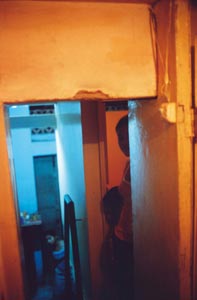UNODC launches Global Initiative to Fight Human Trafficking
The United Nations Office on Drugs and Crime, together with other United Nations agencies, Governments, and NGOs, launched the Global Initiative to Fight Human Trafficking (UN.GIFT) in London on 26 March.
The launch coincided with both the two hundredth anniversary of the abolition of the trans-Atlantic slave trade and the bicentennial of the abolition of the slave trade in the British Empire.
The Global Initiative is designed to motivate Governments, inspire international institutions, empower civil society, strengthen corporate responsibility, build regional alliances, galvanize international media support and mobilize resources to prevent and fight the crime of human trafficking.
A series of events throughout the world will culminate in Vienna with an International Conference against Human Trafficking from 27 - 29 November 2007.
A global problem

|
Brothel in Pnom Penh, Cambodia Photo: Mattia Insolera |
Some 2.5 million people throughout the world are at any given time recruited, entrapped, transported and exploited-a process called human trafficking-according to estimates of international experts. Many believe this number represents the tip of a much greater iceberg.
Trafficking in persons, whether for sexual exploitation or forced labour, affects virtually every region of the world. UNODC reports that persons from 127 countries become exploited in 137 nations.
"Slavery is a booming international trade, less obvious than two hundred years ago for sure, but all around us," said UNODC Executive Director Antonio Maria Costa. "Perhaps we simply prefer to close our eyes to it, as many law-abiding citizens buy the products and the services produced on the cheap by slaves."
Human trafficking has become big business. The United Nations and other experts estimate the total market value of illicit human trafficking at $32 billion-about $10 billion is derived from the initial "sale" of individuals, with the remainder representing the estimated profits from the activities or goods produced by the victims of this barbaric crime.
Most victims of this modern-day slavery are women and young girls, many of whom are forced into prostitution or otherwise exploited sexually. Trafficked men are found in fields, mines and quarries, or in other dirty and dangerous working conditions. Boys and girls are trafficked into conditions of child labour, within a diverse group of industries, such as textiles, fishing or agriculture.
A 2006 UNODC report called "Trafficking in Persons: Global Patterns" identifies Albania, Belarus, Bulgaria, China, Moldova, Nigeria, Thailand and Ukraine among the countries that are the greatest sources of trafficked persons. Belgium, Germany, Israel, Italy, Japan, the Netherlands, Thailand, Turkey and the United States are cited as the most common destinations.
Goal is to End Human Trafficking
The ultimate goal of the Global Initiative is to end human trafficking. The strategy for achieving this starts with efforts to increase public awareness of the problem. The initiative aims to harness and synergize these efforts, get others to join them, and set in motion a broad-based global movement that will attract the political will and resources needed to stop human trafficking. UNODC is the facilitator of the process, channelling existing efforts into a cohesive framework rather than re-inventing the wheel.
"The international community has been discussing this issue for ten years, so we have an idea what should be done," Mr. Costa said.
"We have to decrease the number of victims by preventing trafficking, we have to increase the number of victims who are rescued and supported, and we have to increase the number of traffickers who are convicted. We have the tools to do this but we do not have the political will, large-scale public awareness or the resources to make it happen."
For more information on human trafficking and the Global Initiative, please visit www.unodc.org/trafficking_human_beings.html